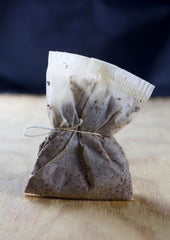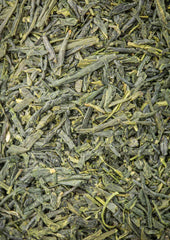When you compare loose leaf tea vs tea bags, there are a few things you will notice. First, a huge difference in the flavor and aroma between the two teas. You will also notice that there is less waste produced by loose leaf tea, and you will have access to so much more variety. In this article, we will go through all the differences between loose leaf vs tea bag tea, why you will prefer loose leaf tea and how to make the switch. Without further ado, let’s get started!
The Difference Between Loose Leaf Tea vs Tea Bags

Let’s start this comparison of loose leaf tea vs tea bags with a quick definition of terms.
Loose leaf tea is just what it sounds like, dried loose tea leaves intended to be brewed in a teapot or strainer.
Teabags on the other hand are small, semi-permeable packets with tea leaves inside.
It may seem on the surface like these two would produce the same finished product, but that could not be further from the truth.
History of tea bags
Contrary to popular belief, tea was consumed in loose leaf form for virtually all of its history. It's only in the last 100 years or so that the teabag was even used. The most likely theory states that it was developed as an accident. The american tea merchant Thomas Sullivan portioned out tea into single use packets in 1908 and a customer mistakenly dipped the whole pouch into hot water. This became the first teabag.
Larger tea companies began to take notice of this quicker way to prepare a cup of tea, and soon producing tea inside bags became the norm. Producing tea in teabags also meant that lower quality leaves could be used and they could be mass-produced for convenience sensitive consumers.
Component of Loose leaf vs tea bags

One advantage of loose leaf vs tea bags is that loose leaf tea contains only one ingredient: tea leaves. Teabags on the other hand can contain many different ingredients.
A typical teabag is made of either nylon, plastic or bleached paper. It then is either sealed with a staple or plastic-based glue. Then, most teabags have a string on them, which can also effect the flavor of the cup of tea.
This may not sound like much of a big deal, but when you drop this teabag into boiling water, it will start to extract some of the chemical components of the teabag itself in addition to the tea leaves.
Loose leaf teas are made with high quality leaves
The best teas in the world are all created for loose leaf consumption. Here the producers select the best quality leaves and carefully produce them in small batches. With some batches, a tea farmer will even have a specific taste profile they are trying to capture, and they will work meticulously to perfect the perfect flavor balance. Every step from the growing to the processing to the blending is done to improve the flavor of the tea. The consumers of loose leaf tea are much more sensitive to quality, and less sensitive to convenience. For this reason, there is a great disparity between the flavors of loose leaf tea vs tea bags.
Tea bags are made of Dust

Teabags tend to contain much lower quality leaves than loose leaf tea. In order to get large tea leaves into a teabag, they have to be broken down and therefore they will lose a lot of their essential oils, which are responsible for the complex flavors and aromas of a tea.
A producer making high quality tea for a premium market would never waste the leaves in a teabag, so all of the best teas in the world are made for loose leaf consumption.
Teabags are made with the casual tea drinker in mind, and therefore they are mass produced using cheaper leaves. Teabags are often made from the leftover leaves from the tea production process. They can be made from later harvests with less nutrients or contain older leaves, stems or other plant material.
The flavor of loose leaf tea vs tea bags couldn’t be more different, with the teabags having a flat and bitter flavor and loose leaf green tea having a sweet and complex assortment of flavors.
Standardization vs. Variety
In addition to getting better quality tea, you also get more variety when you choose loose leaf vs tea bag tea. Tea bags are mass-produced by just a handful of large companies. Because the quantity being produced is so large, there are only a few different options. When you look at the grocery store, you will mostly see generic “green tea” teabags. If you really want to explore different varieties within green tea, you will have to go for loose leaf, otherwise you are just getting the cheapest green tea stuffed into a bag.
Once you make the switch to loose leaf tea, you now have access to the thousands of small tea farms all around the world. These farmers produce tea in very small quantities and the taste is one of a kind. The subtlety and nuance you get from small batch teas is impossible to find in the mass produced teabags.
Why are loose leaf teas better than tea bags
#1 health benefit - tea bags are toxic

It was recently found that 11.6 billion microplastics and 3.1 billion nano plastics can be released into a single cup of tea when you use a teabag.
These microplastics are released when the hot water interacts with the chemicals in the teabag. When you drink a cup of tea, you are drinking a very small amount of plastic but even though the quantity is limited, it still adds up overtime.
On first glance, paper teabags may seem like they are the least bad alternative, but this can be misleading. This is because the paper teabags are usually treated with a type of bleach to make them white.
This bleaching process uses chemicals like chlorine dioxide, which can be dangerous. Although this trick is used to make the teabags look clean and pure, the opposite is actually true.
#2 taste
Teabags can be used as a way for companies to disguise lower quality tea leaves and sell them. On the outside, teabags look relatively similar but when you open them up you can see the quality is very poor compared to premium loose leaf green tea. Unfortunately, teabags are often made from the leftover leaves of the tea production process. They can also be made from later harvests, with lower nutrient profile and a bitter, flatter flavor.
#3 environmental impact
The material in the teabags aren’t just bad for the flavor, they’re also bad for the environment as well. Another reason you should not drink teabags is that they can be a environmental disaster. It’s estimated that in Great Britain alone, there are 100 million cups of tea drunk every day. With 96% of that being teabags, that’s as many as 35 billion teabags thrown out each year.
This is not just paper but in many cases it contains harmful plastics, metal from the staples and string. Keep in mind that a lot of teabags are also individually wrapped, creating even more material waste. A good way to reduce all this extra waste is to switch to loose leaf tea. Loose leaf tea is far more efficient in terms of packaging and when you are done with the tea, you can actually compost the leaves in the soil! This leads to a huge improvement in the sustainability of loose leaf tea vs tea bags.
Loose Leaf Tea vs. Tea Bags Cost
Teabags may seem like a cheaper option, but they are actually more expensive than you might think. For example, a cheaper loose leaf tea like Bancha can be $16 for 100 grams whereas tea bags may cost around 20 cents for 2 grams of actual tea. Bancha can be used 5-6 times without losing its flavor whereas a tea bag will lose its flavor after one brewing. That means that you can get 100 or more cups of good quality tea out of one $16 pack of Bancha. As a result, the cost of loose leaf tea vs tea bags is quite similar.
Pros and Cons of Loose Leaf Tea
Pros
When you go for premium quality loose leaf tea, you will see the difference right away. You can examine the leaves and the various shapes they take on and you can watch how they interact with the water. There is definitely a richer experience that comes from not only tasting your tea, but also watching it brew, as the leaves expand and give off a pleasant aroma.
Cons
If you have the proper tools, brewing loose leaf tea doesn’t need to take much time in your day. You just need to add the leaves to the teapot, pour in some warm water and then pour it out a minute later. This takes roughly the same amount of time as opening up a teabag and brewing it, but the taste is so much better. There are small improvements you can make overtime to get better results from your tea brewing, but the basic principles are simple.
Making matcha can be even easier than preparing a tea bag, you just need to add the powder to the bowl, pour in the water and then stir it up. You don’t have to let it sit and brew and you also don’t need to wait for the water to reach boiling because it doesn’t need to be that hot to extract the flavor. There are certain measurements that can create better bowls of matcha, but once you get used to it you will be able to prepare your matcha without measuring anything.
Pros and Cons of Tea Bags
Pros

The only real pro of teabags is that they can be more convenient. If you only have 20 seconds in the morning to make tea, you can just simply throw a teabag into boiling water, let it sit for a little while and then drink it quickly.
There is so much more tea has to offer than just a hurried beverage. If you take your time and enjoy the preparation and drinking of your loose leaf tea, it will open up a whole new world for you.
If you absolutely need the teabag, you can just find empty teabags online and fill them with your own loose elaf tea. This way you get the convenience of the teabag but with much better quality.
Cons
A tea bag is not a good way to brew green tea. Tea leaves need plenty of space to open up fully and release their flavor into the water. When the leaves are crammed into a teabag, they do not have enough space to open up and this is one of the many reasons why tea bags produce lower quality tea compared to loose leaf. What you want to do is take loose leaf tea and brew it in a teapot that has a built in strainer like this Kyusu.
How to Switch to Leaf Tea

Switching to loose leaf tea can be both easy and fun, you just need to get a teapot. We’ve made this transition easier for you with our monthly tea club.
With this offer, we’ll send you a free kyusu teapot with your first month, as well as our two most popular loose leaf green teas. We’ll then send you additional green teas tea try at a 16% discount as often as you’d like. You can sign up today and cancel anytime!
Where can I buy good loose leaf tea?

If you are looking to try some good loose leaf tea, we have tons of options for you. Over the past few years, we have traveled all around Japan meeting with dozens of different farmers and sampling hundreds of different teas.
We have selected 30 of our favorites to share with everyone in a collection of teas we called the japanese tea sampler mega 30 pack. In this sampler, you’ll get to try 30 different kinds of matcha, sencha, gyokuro, hojicha, genmaicha, bancha, kukicha and kamairicha all in one place. Try them out and let us know which ones you like most!
The final word about loose leaf vs tea bag

Teabags are the first experience many of us have with the world of tea, and they can be convenient on certain occasions but once you learn how to prepare loose leaf tea, it will open up a whole new world for you.
You will have access to so many different types of teas and you will be able to experiment with different ratios and brewing methods so you can easily find what works best for you. In the next segment, we will discuss how easy and rewarding it can be to prepare your own loose leaf green tea at home!




